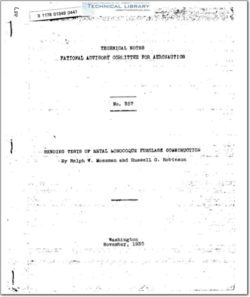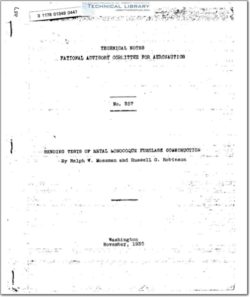naca-tn-357

- Version
- 235 Downloads
- 2.16 MB File Size
- 1 File Count
- April 23, 2016 Create Date
- April 23, 2016 Last Updated
National Advisory Committee for Aeronautics, Technical Notes - Bending Tests of Metal Monocoque Fuselage Construction

Monocoque or shell—type fuselages are such fuselages as
rely on the strength of the skin to carry either the shear or
the loads due to bending moment. They may be divided into three
classes — monocoque; semimonocoque, and reinforced shell - and
different parts of the same fuselage may be in any of the three
classes. :
In the true monocoque the only reinforcing members, if any,
are vertical bulkheads formed of structural members. The semi—
monocoque has the skin reinforced by longerons and vertical
bulkheads, but has no diagonal web members. The reinforced shell
has the skin reinforced by a complete framework of structural
members.
The usual type of monocoque and semimonocoque fuselage uses
corrugated skin, with the corrugations parallel to the thrust
axis, or smooth skin. For the same thickness of sheet the cor—
rugated Skin is stronger than the smooth skin, but it is also
heavier and the aerodynamic efficiency is not as high. There
are also structural difficulties with the corrugated skin that
are not present in the smooth skin types.
Smooth skin, true monocoque, fuselage sections were used in
this investigation. The curved sheet is the element common to
all types of monocoque construction — plain circular or ellip—
tical sections, corrugated circular or elliptical sections,
rectangular sections with rounded—off corners, or any of thesev
sections combined with longitudinal stiffeners. Therefore, it
was decided to study the thin curved sheet only, as nearly as
possible, eliminating stiffening of every kind with the excep—
tion of a bulkhead ring. It is realized that this is only the
first step toward the complete solution of the more complex
sections. The section tested is the most logical first step in
that it is the simplest and has only one variable, the D/t
ratio. If the relation between the maximum stress and D/t can
-be determined, the results will be useful in analyzing all sec—
tions containing curves.
The cylinders for this work were constructed and donated
by The Douglas Aircraft company of Santa Monica. The Engineer—
ling Department of the Douglas Company suggested the problem,
and their advice, especially that of Mr. A. E. Raymond, was very
helpful in all stages of the project.
| File | Action |
|---|---|
| naca-tn-357 Bending Tests of Metal Monocoque Fuselage Construction.pdf | Download |
Comment On This Post